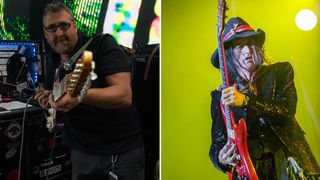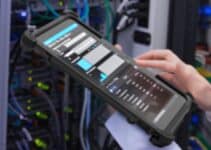
A short while ago, Joe Perry was struggling with his tone. That’s not to say his chops had faded; it was more a matter of years of sonic exploration having left things a bit muddy.
Luckily, just as he was preparing for Aerosmith’s impending Las Vegas residency, he met Darren Hurst, a man who, in almost no time at all, helped Perry re-unlock the signature sounds that made Aerosmith one of the greatest rock bands in history.
“I had done five years with Peter Frampton, and as we know, Peter had announced that he was retiring,” Hurst says. “While I was off the road, I got a call from a friend named Aidan Mullen, bass tech for Def Leppard and a friend of the Aerosmith camp. He said, ‘I don’t know your plans for the next few years, but Joe Perry is hurting and needs a tech.’
“He said Joe is a great guy who’s great to work for, so I said, ‘Sure, give him my number!’ I got a call from Joe the following Saturday, and before I knew it, I was in Vegas. Once I got there, I was able to get the guitars sounding better than before. Joe said, ‘How do I keep you?’”
It’d be all too easy to simplify what Perry does. A Strat here, a Les Paul there. Oh, and a backline of vintage tube amps. Not too crazy, right? Wrong.
“I’ve been a Joe Perry fan for years,” Hurst says. “I know what Joe’s sound is. I’ve been in the crowd for dozens of Aerosmith shows at various points in my life. Combined with my years as a tech, I was able to figure out what Joe needed to deliver those iconic songs.”
When asked to explain the secret to Perry’s sound, Hurst says, “It’s not a high-gain sound, but you need a certain amount of drive and a bit of a mid-bump, too. Naturally, when I think about those sounds, I lean toward pieces of gear. But that’s tricky because Joe has a massive collection of gear, which was part of the issue. The difficulty is that he wanted to use everything, and things had gotten homogenized.”
When Hurst arrived in Vegas, the first order of business was simplifying Perry’s rig while still satiating the guitarist’s thirst for sonic exploration. In short, Perry had a lifelong case of G.A.S. (Gear Acquisition Syndrome), and Hurst – who surely sympathizes – was just what the doctor ordered.
“When I got there, Joe had a Marshall JCM, a Fender, a Magnatone, and a bunch of pedals,” Hurst says. “But the big issue was that the gain structure was all wrong from what I thought he needed. So I just re-voiced everything and dialed in that classic gain structure that Joe made famous. We’ve all heard the songs and solos, so that sound has been out there for a long time.
“You need drive for the solos – but remember, Joe’s rhythm playing is very powerful and clean sounding. It’s clean but also has just a little bit of breakup. You want that creamy, clean sound and smooth sustain, but you also want a bit of grit. So I first ran things through a compressor on the front end for some clean tones – then I added the Ibanez Tube Screamer [TS9].”
For Hurst, adding gear was the fun part. But remember – Perry has a ton of gear, which was commingling in not-so-satisfactory ways. So, it was critical for Hurst to refrain from being the proverbial kid in the sandbox, meaning he needed to remove gear from the equation, no matter how tasty it was.
“Joe loves gear,” Hurst says. “His collection is so massive, and there’s a lot of stuff to pick through. He’s a tweaker and a tone chaser, and if we hit a bar, he wants to raise it right away. But I love that about Joe because it’s dangerous, which is what rock music is about. There’s absolutely no predictability to this. And that’s a challenge for me because that lack of predictability means I need to keep him inspired.
“If you know anything about Joe, you’ll know he rarely plays the same songs on the same guitars. He might use a Telecaster for Sweet Emotion one night and a Les Paul the next. Other times he’s on a Strat kick; other nights, he only wants to play hollowbody guitars.
“But he wants the flavors and fingerprints of those guitars to stand out, so building a rig is a challenge. My main goal is to build Joe a rig that allows the essence of his guitar collection to shine through, no matter what guitar he chooses – and I’ve done that.”
It’s an interesting spot to be in when your job is to dial in the sound of a legend, especially when said legend is not remotely beholden to anything he’s done in the past, no matter how iconic or beloved it might be. It’s a balancing act, to say the least.
“When Joe is in soundcheck, he’ll ask me, ‘How does the rig sound?,’ and if I give him the thumbs up, we ride the gauntlet. But depending on where he’s leaning, I’ll change the rig – sometimes pretty damn significantly – because he’s always looking for something new. Lately, with the Hollywood Vampires, Joe has been going with the Marshall JCM100, the TS9, and a Klon Centaur.
“He has an original Klon that he picked up with Brad [Whitford] in the Nineties – but I don’t keep that on his board. When we tour with Aerosmith, I might have the original there, but while on the road with the Vampires, too many people at these festivals could swipe it. So I’ve been going with what I feel is the best reproduction on the market today, the Warm Audio Centavo.”
When asked if there’s a piece of gear that Perry explicitly doesn’t like or has banned from his rig, Hurst says, “The cool thing about Joe is that he’s open to anything. Our rule is, ‘Let’s try it. If it doesn’t work, we don’t do it again.’ You never know if something new will be right for all situations, but Joe is open to pretty much anything, including building new rigs from the ground up, which is inspiring and fun.”
When most of us think of Joe Perry, the lasting impression in our minds tends to skew toward a select few guitars, such as his ’59 Les Paul or his beloved “Burned Strat.” Hurst, however, has a different take.
“For me, it’s the 10-string B.C. Rich Bich. I don’t know what it is, but something happens to Joe when he picks up that guitar. It’s featured in the photos for the Live! Bootleg record, I think, and I had that poster on my wall as a kid. When Joe straps on that guitar, something special happens.”
Thinking about other favorites, Hurst continues, “The Frankenstein [Burned] Strat with the upside-down headstock is another special guitar. It’s got a Tele neck and two P90s, and we put a VegaTrem on it there, too. I moved the volume control for Joe, who seems very comfortable with it.
“There have been nights that, apart from maybe grabbing a Gretsch or something, he plays nearly the whole show with it. It’s become iconic, but that’s subject to change if you know Joe. He loves to switch it up, and that’s why I love working for him.”
Thank you for reading 5 articles this month**
Join now for unlimited access
US pricing $3.99 per month or $39.00 per year
UK pricing £2.99 per month or £29.00 per year
Europe pricing €3.49 per month or €34.00 per year
*Read 5 free articles per month without a subscription
Join now for unlimited access
Prices from £2.99/$3.99/€3.49



